|
Hiram Bingham, the American explorer who found the
ruins of Machu Picchu in 1911, wrote:
The religion of
ancient peoples, as well as their manners
and customs, depended, in large measure, on
the climate of the region where they lived.
If it was a warm region where the sun was
oppressively hot in the middle of the day
and the nights were pleasant and cool, there
was less temptation to worship the sun. On
the other hand, there was a marked tendency
to worship the stars and the moon.
Familiarity with these heavenly bodies led
to that knowledge of astronomy, and even
astrology, which is so marked a feature of
Arabian civilization as well as that of the
Mayas in Central America.
On the other
hand, in the high Andes, on the Peruvian
plateau, where the rarefied atmosphere does
not retain the sun's heat and the nights are
bitterly cold, it is not surprising that
little attention was paid to the stars,
while the most profound worship was accorded
the sun. Other natural phenomena such as
thunder and lightning, high mountains,
dangerous precipices, and water-falls, came
within their ken and naturally were
propitiated by offerings and a certain
amount of worship so as to protect human
beings from harm.
|
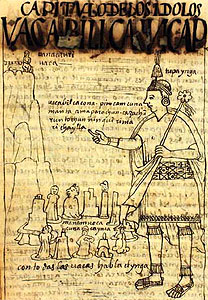
Divinities of the Inka, Waqa willka inkap.
Illustrations from 1615 by
The "Indian Chronicler" Felipe Guaman Poma. |
Most important
of all, naturally, was the sun, without
which crops would not grow, and life,
generally, was intolerable. Its favor must
be sought. As the sun went farther and
farther north and the shadows lengthened in
the month of June, it was natural to fear
that the sun would continue its flight to
the north and might leave them eventually to
freeze and starve. Consequently the priests
of the sun, able, on the twenty-first or
twenty-second of June, to stop its flight
and tie it to a stone pillar in one of their
temples, were regarded with veneration. When
the shadows ceased to lengthen and became
shorter until the sun was once more overhead
and his kingdom firmly established there
would naturally be great rejoicing. The
period of the summer solstice was one of joy
just as that of the winter solstice was one
of fear. It is probable that the priests of
the Sun, whose lives depended on their being
successful in appearing to control his
actions, had learned to read the length of
the shadows cast by the huge sundials called
intihuatana, or, "the place to which
the sun is tied."
|
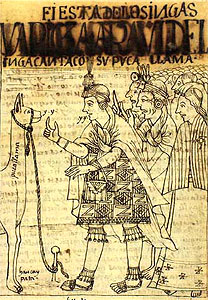
Feast of the Inkas: wariqsa, dance; arawi,
song of the Inka. He sings with his red llama.
Illustrations from 1615 by
The "Indian Chronicler" Felipe Guaman Poma. |
One naturally
expects to find these sacred stones within
the enclosure of the sanctuary or temple
where the sun was worshipped and where the
Chosen Women were taught to become his
hand-maidens. There they learned to be
useful wives for priests and nobles who
could depend on them to weave beautiful
garments, cook toothsome dishes, and brew
excellent chicha with which the heart
of man might be made glad and his spirit
raised from the heaviness caused by toil or
fear.
One of the most
important spots in the Andes would be the
ruins of a sanctuary with its temples of the
Sun, Moon and Stars, its intihuatana,
its supply of good fresh water for chicha,
its palaces for nobles and priests and its
dormitories for the women who had been
chosen to be Virgins of the Sun. Such a
sanctuary had been encountered by Pizarro
and the conquistadors when they entered
Cuzco. We found one somewhere else. It was
constructed with the utmost care by the most
skillful architects and masons in the most
inaccessible parts of the Andes.
|
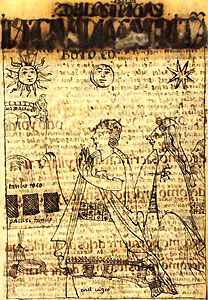
Idols of the Inkas: Inti, Uana Cauri, Tambo Toco, Pacari
Tambo.
Illustrations from 1615 by
The "Indian Chronicler" Felipe Guaman Poma. |
Source:
‘Lost City of the Incas, The Story of Machu
Picchu and its Builders’ by Hiram Bingham
The American explorer who found the ruins of Machu Picchu in 1911.
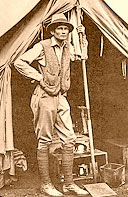
Hiram Bingham at Machu Picchu
The inspiration for Indiana Jones?
Source:
Illustrations:
Guaman Poma - 'El primer Nueva
corónica y buen gobierno'.
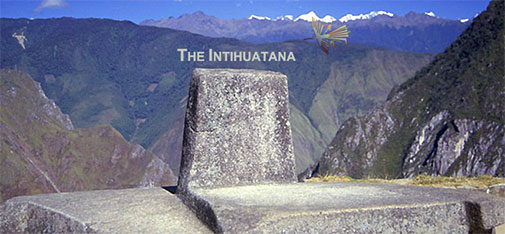
The Intihuatana stone, the 'hitching post of
the sun' at Machu Picchu.
|